News
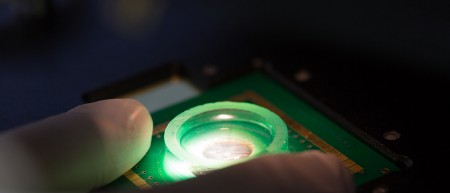
Our LTP offer
Does your compound modulate LTP?
FAST TURN-AROUND
We have optimized our internal production process of LTP recording to address cognition and neurodegeneration programs with very attractive prices and fast turn-around.
We propose a new offer to evaluate:
- 1 compound / 1 concentration
- 1 compound / 3 concentrations

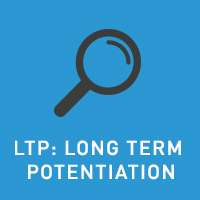
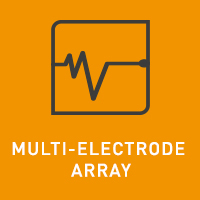
Long-Term Potentiation (LTP) is one of the main synaptic plasticity mechanisms which are fundamental for basic learning tasks and higher cognitive functions. Multi-Electrode Array (MEA) recordings provide an exceptional macroscopic view of native neuronal network with quick turnaround: ideal to bridge the gap between cellular and in vivo assays, to confirm compound activities and/or investigate their mechanism(s) of action.
Few examples: reference compounds effect on LTP
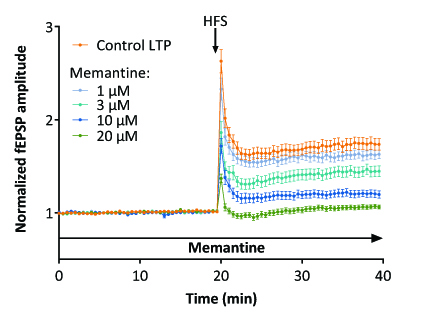 EVALUATION OF NMDA NON-COMPETITIVE ANTAGONIST ON Long Term Potentiation – Illustrated is the dose-dependent inhibition of Long Term Potentiation by the non-competitive NMDA receptor antagonist, Memantine, in the CA1 region of rat hippocampal slices.
EVALUATION OF NMDA NON-COMPETITIVE ANTAGONIST ON Long Term Potentiation – Illustrated is the dose-dependent inhibition of Long Term Potentiation by the non-competitive NMDA receptor antagonist, Memantine, in the CA1 region of rat hippocampal slices.
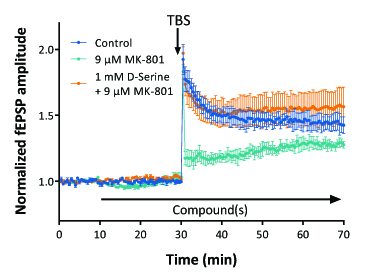 REVERSAL OF MK-801-LTP DISRUPTION BY D-SERINE – LTP induced by Theta-Burst Stimulation (TBS) is largely decreased by MK-801 (with an approximate IC50 of 9 µM). Pre-exposure with 1 mM D-Serine prevents the MK-801-induced LTP disruption.
REVERSAL OF MK-801-LTP DISRUPTION BY D-SERINE – LTP induced by Theta-Burst Stimulation (TBS) is largely decreased by MK-801 (with an approximate IC50 of 9 µM). Pre-exposure with 1 mM D-Serine prevents the MK-801-induced LTP disruption.
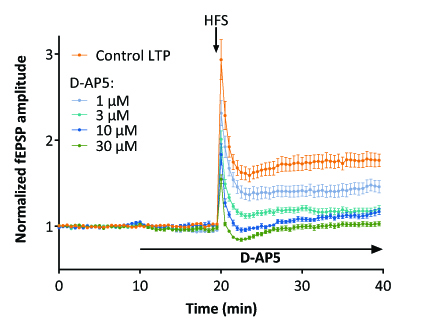 EVALUATION OF NMDA COMPETITIVE ANTAGONIST ON LTP – Illustrated is the dose-dependent inhibition of Long Term Potentiation by the competitive NMDA receptor antagonist, D-AP5, in the CA1 region of rat hippocampal slices.
EVALUATION OF NMDA COMPETITIVE ANTAGONIST ON LTP – Illustrated is the dose-dependent inhibition of Long Term Potentiation by the competitive NMDA receptor antagonist, D-AP5, in the CA1 region of rat hippocampal slices.
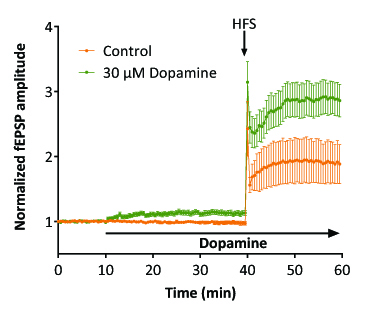 EVALUATION OF DOPAMINERGIC AGONIST ON LTP – Pre-exposure with 30 µM Dopamine largely increased Long Term Potentiations amplitude in the CA1 region of rat hippocampal slices.
EVALUATION OF DOPAMINERGIC AGONIST ON LTP – Pre-exposure with 30 µM Dopamine largely increased Long Term Potentiations amplitude in the CA1 region of rat hippocampal slices.
Materials & Methods
Slices preparation
- Experiments carried out with 8 to 12 week-old C57Bl6 mice*
- 350 µM thick hippocampal slices prepared with a McILWAIN tissue chopper
- Hippocampal slices continuously perfused with oxygenated ACSF (bubbled with 95% O2–5% CO2) at the rate of 3 mL/min
Stimulation/Recording protocols and compound application
- Schaffer Collaterals stimulation, recording of evoked-responses (fEPSP) in the CA1 region
- Stimulation intensity set to 40%* of Imax
- Long Term Potentiation Recording:
- 10 minutes in control condition (Baseline)
- 30 minutes* of compound exposure
- LTP triggered by a High Frequency Stimulation (HFS)* of the afferent pathway
- 60 minutes of recording after tetanus (in the continuous presence of the compound)
Number of samples
- Evaluation of 1 concentration: n = 10 slices (n=5 compound-exposed slices + n = 5 control slices)
- Evaluation of 3 concentrations: n = 23 slices (n=5 compound-exposed slices per concentration + n = 8 control slices)

